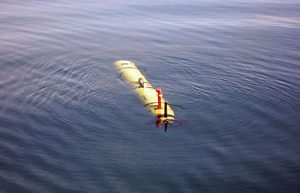Passive Ballast
Inventors: Jeff Kaeli, Robin Littlefield, Mike Jakuba, and Brian Guest
Patent No. US10,640,188 B1

Overview: Autonomous underwater vehicles (AUVs) are typically positively buoyant, to ensure a fail-safe recovery if the vehicle faults. This means the AUV must constantly fight its own buoyancy to dive or maintain a depth during a mission, often achieved by pitching the AUV downward. Constant downward pitch induces drag, requires increased power, and shortens mission length. Standard active ballast systems have significant space and power demands and are not suitable for small AUVs.
Technology: The Passive Ballast and Semi-Passive Ballast systems take advantage of ambient water pressure to achieve both positive buoyancy while on the surface and neutral buoyancy while submerged, all while requiring no or very little power. The Passive Ballast system utilizes a responsive chamber that compresses in response to increased ambient pressure, decreasing the AUV’s buoyancy as the chamber decreases in volume as the AUV dives. The system is tunable to achieve neutral buoyancy at a user-specified depth. The Semi-Passive Ballast system can decouple the system from the ambient pressure enabling a buoyancy lock-in.
CONTACT
To learn more about this opportunity please contact:
The Office for Technology Transfer
- Email: techtransfer@whoi.edu
- Phone: (508) 289-3447

